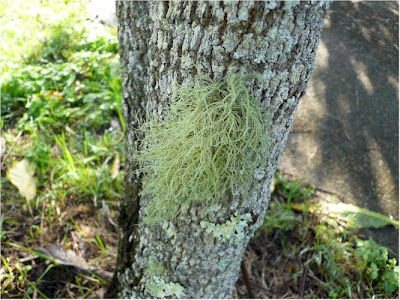
Make a wish, a rainbow in winter is not common.



Lichen love
Few other organisms play a more crucial role in the Australian ecosystem than lichens. The termites of the plant world, lichens extract and recycle nutrients, crumbling rocks to create the soil other plants need to survive.
Lichens are a strange assemblage of fungi and algae existing in a symbiotic relationship. The fungi are mostly of the genus Ascomycota, and the algae are single-celled organisms such as green or blue-green algae. In flat lichens, the algae dwell in layers between the fungi like a slime sandwich.
Although the relationship is complex, the algae's essential role is to share carbon with the fungi, which in turn scrapes nutrients from the surface it's attached to and provides the algae with somewhere to live.
Lichen can form flat crusts, bumpy or lobed masses, and fibrous fronds that hang like witches hair from the trees in temperate forests.
www.abc.net.au/science/scribbly gum/ by Heather Catchpole
 Bull Bay Magnolia offers its bark to a wide range of fascinating Lichens in different forms and colours. It also plays host to small native orchids.
Bull Bay Magnolia offers its bark to a wide range of fascinating Lichens in different forms and colours. It also plays host to small native orchids. In medieval times, a purple dye discovered in lichen of the genus Roccella revolutionised the fashion industry. This dye brought royal purple, a colour previously extracted from the glands of tens of thousands of sea snails, to the masses. Lichen purple, which required as much lichen as material to make the dye, was popular until it was replaced by a synthetic purple made from aniline.
Lichen reacts very quickly to pollution, which kills the algal component, leaving the fungi unable to fend for itself. Different species are susceptible to different levels of pollution so their presence or absence in an area is an indicator of the quality of the air.
Lichen are nature's little indicator in several ways. Litmus paper, used to differentiate between acid and alkaline substances, is made from the same lichen which once supplied purple dye.
www.abc.net.au/science/scribbly gum/ by Heather Catchpole
 Lichens in different colours grow on the bark of Tibouchina Noelle. Look at the green neon colour together with white and blue.
Lichens in different colours grow on the bark of Tibouchina Noelle. Look at the green neon colour together with white and blue.  Fantastic landscape lichen.
Fantastic landscape lichen.  This one looks like a snow flake. Many more grow on the bark of this tree.
This one looks like a snow flake. Many more grow on the bark of this tree. Lichens are significant in Australia because of their ecological importance, aesthetic value, and usefulness to humanity. A lichen is one of the most remarkable alliances in nature. It can be regarded as a community rather than an organism because it always consists of at least one species of alga and one species of fungus. The algal portion of the lichen is its photosynthetic component and is very sensitive to sulphur dioxide in the atmosphere. The fungal portion usually makes up the bulk of the plant; it is drought resistant and able to withstand periods of hot and cold temperatures and dryness with no ill effect to the lichen which remains dormant. This makes the lichen a useful monitor for both pollution and water relations, that is, assessing the amount of water absorbed through the surface of the lichen in relation to the available moisture in the atmosphere.
 Lichen spores prefer the bark of some trees. When they are happy they produce the most beautiful patterns.
Lichen spores prefer the bark of some trees. When they are happy they produce the most beautiful patterns. Air pollution close to cities, highways and around factories denudes these areas of sensitive lichens. The renowned sensitivity of lichens to air pollution derives from an ability to concentrate air- or water-borne compounds in the plant body, potentially to lethal levels. Sulphur dioxide, fluoride, lead and zinc are common causes of death in lichen populations. Aerial application of fertilisers, fungicides and insecticides is also likely to have a significant impact on the non-vascular flora.
 I passed the beautiful Hana Fuki...and I couldn't resist!
I passed the beautiful Hana Fuki...and I couldn't resist!Believe it or not: Build a bridge and get over it!
Organic tip of the week:
COMPASSION IN ACTION A growing number of socially responsible manufacturers have recognised the cruelty of animal testing. By buying only "cruelty free" products and by voicing their complaints to companies that still use animal tests, consumers play a vital role in eliminating cruel test methods.
Please buy cosmetics which are labeled cruelty free not tested on animals.
http.www.crueltyfreeshop.com.au
Thank you for visiting and have a nice day.
Copyright T.S. Yesterdaytodayandtomorrow in my garden.
Photos from my garden. T.S.














































